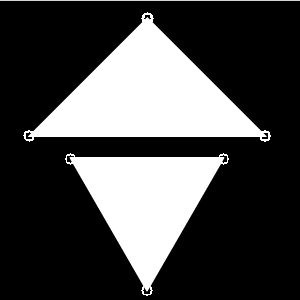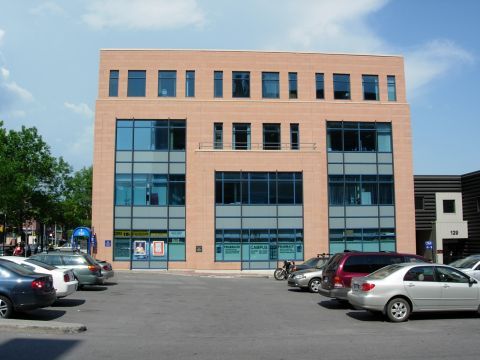利用形态学检测边缘和角点
一、引言
形态学滤波器可以用于检测图像的不同特征,这一节,我们介绍利用形态学检测灰度级图像的边缘和角点。
二、原理介绍
形态学还是将图像的灰度级看成地理里面的“等高线”,亮的地方看成山峰,暗的地方看成低谷,中间部分就是峭壁。形态学中的腐蚀(eroded),会把山谷扩展,峭壁减少;相反的,膨胀(dilated)会把山谷减少,峭壁扩展。在两种情况下,中间(大块的山峰和低谷)不会改变太多。
利用形态学进行边界检测原理很简单,就是将一幅图片分别经过腐蚀和膨胀处理,然后图像相减,在进行门限处理,消除小的噪声。(当然也可以利用腐蚀或者膨胀后的图像和源图像相比,得到的边界会相对细些)当结构元素越大,得到的边界越粗。
利用形态学进行角点检测比较麻烦。角点检测分别使用十字角,菱形,X形,方形四种结构元素进行腐蚀和膨胀。(1)我们以方形图像为源图像介绍,第一步对图像进行结构元为十字角的膨胀,然后在进行结构元为菱形的腐蚀;第二步对源图像进行结构元为X形的膨胀,在进行结构元为方形的腐蚀。第一步的作用是检测直角角点,第二步的作用是检测斜45°的角点。
图1 源图像,图2 Dilate with a cross ,图3 Erode with a diamond,图4 Dilate with a X,图5 Erode with a square ,图6 Corner Image,图7 Corners on Image
(2)选取等腰三角形和等边三角形作为源图像进行处理,可以看出与四个机构元处理的结果
图1 源图像,图2 Dilate with a cross ,图3 Erode with a diamond,图4 Dilate with a X,图5 Erode with a square ,图6 Corner Image,图7 Corners on Image
三、opencv函数介绍
头文件:#include
函数定义:
//! erodes the image (applies the local minimum operator)
CV_EXPORTS_W void erode( InputArray src, OutputArray dst, InputArray kernel,
Point anchor=Point(-1,-1), int iterations=1,
int borderType=BORDER_CONSTANT,
const Scalar& borderValue=morphologyDefaultBorderValue() );
//! dilates the image (applies the local maximum operator)
CV_EXPORTS_W void dilate( InputArray src, OutputArray dst, InputArray kernel,
Point anchor=Point(-1,-1), int iterations=1,
int borderType=BORDER_CONSTANT,
const Scalar& borderValue=morphologyDefaultBorderValue() );
//! applies an advanced morphological operation to the image
CV_EXPORTS_W void morphologyEx( InputArray src, OutputArray dst,
int op, InputArray kernel,
Point anchor=Point(-1,-1), int iterations=1,
int borderType=BORDER_CONSTANT,
const Scalar& borderValue=morphologyDefaultBorderValue() );函数参数:
erode(腐蚀函数): InputArray src, 原图像
OutputArray dst, 结果输出图像
InputArray kernel, 结构元素
Point anchor=Point(-1,-1), 结构元素的原点
int iterations=1, 迭代次数
dilate(膨胀函数):InputArray src, 原图像
OutputArray dst, 结果输出图像
InputArray kernel, 结构元素
Point anchor=Point(-1,-1), 结构元素的原点
int iterations=1, 迭代次数
morphologyEx : InputArray src, 原图像
OutputArray dst, 结果输出图像
int op,cv::MORPH_OPEN(打开) cv::MORPH_CLOSE(关闭) cv::MORPH_GRADIENT(梯度)
InputArray kernel, 结构元素
Point anchor=Point(-1,-1), 结构元素的原点
int iterations=1, 迭代次数
四、例程
程序:
morphoFeatures.h
#if !defined MORPHOF
#define MORPHOF
#include
#include
class MorphoFeatures {
private:
// threshold to produce binary image
int threshold;
// structuring elements used in corner detection
cv::Mat cross;
cv::Mat diamond;
cv::Mat square;
cv::Mat x;
void applyThreshold(cv::Mat& result) {
// Apply threshold on result
if (threshold>0)
cv::threshold(result, result, threshold, 255, cv::THRESH_BINARY_INV);
}
public:
MorphoFeatures() : threshold(-1), cross(5,5,CV_8U,cv::Scalar(0)),
diamond(5,5,CV_8U,cv::Scalar(1)),
square(5,5,CV_8U,cv::Scalar(1)),
x(5,5,CV_8U,cv::Scalar(0)){
// Creating the cross-shaped structuring element
for (int i=0; i<5; i++) {
cross.at(2,i)= 1;
cross.at(i,2)= 1;
}
// Creating the diamond-shaped structuring element
diamond.at(0,0)= 0;
diamond.at(0,1)= 0;
diamond.at(1,0)= 0;
diamond.at(4,4)= 0;
diamond.at(3,4)= 0;
diamond.at(4,3)= 0;
diamond.at(4,0)= 0;
diamond.at(4,1)= 0;
diamond.at(3,0)= 0;
diamond.at(0,4)= 0;
diamond.at(0,3)= 0;
diamond.at(1,4)= 0;
// Creating the x-shaped structuring element
for (int i=0; i<5; i++) {
x.at(i,i)= 1;
x.at(4-i,i)= 1;
}
}
void setThreshold(int t) {
threshold= t;
}
int getThreshold() const {
return threshold;
}
cv::Mat getEdges(const cv::Mat &image) {
// Get the gradient image
cv::Mat result;
cv::morphologyEx(image,result,cv::MORPH_GRADIENT,cv::Mat());
// Apply threshold to obtain a binary image
applyThreshold(result);
return result;
}
cv::Mat getCorners(const cv::Mat &image) {
cv::Mat result;
// Dilate with a cross
cv::dilate(image,result,cross);
// Erode with a diamond
cv::erode(result,result,diamond);
cv::Mat result2;
// Dilate with a X
cv::dilate(image,result2,x);
// Erode with a square
cv::erode(result2,result2,square);
// Corners are obtained by differencing
// the two closed images
cv::absdiff(result2,result,result);
// Apply threshold to obtain a binary image
applyThreshold(result);
return result;
}
void drawOnImage(const cv::Mat& binary, cv::Mat& image) {
// cv::Mat_::const_iterator it= binary.begin();
// cv::Mat_::const_iterator itend= binary.end();
cv::Mat_::const_iterator it= binary.begin();
cv::Mat_::const_iterator itend= binary.end();
// for each pixel
for (int i=0; it!= itend; ++it,++i) {
if (!*it)
cv::circle(image,cv::Point(i%image.step,i/image.step),5,cv::Scalar(255,0,0));
}
}
};
#endif
main.cpp
#include
#include
#include
#include "morphoFeatures.h"
int main()
{
// Read input image
cv::Mat image= cv::imread("../building.jpg",0);
if (!image.data)
return 0;
// Display the image
cv::namedWindow("Image");
cv::imshow("Image",image);
// Create the morphological features instance
MorphoFeatures morpho;
morpho.setThreshold(40);
// Get the edges
cv::Mat edges;
edges= morpho.getEdges(image);
// Display the edge image
cv::namedWindow("Edge Image");
cv::imshow("Edge Image",edges);
// Get the corners
morpho.setThreshold(-1);
cv::Mat corners;
corners= morpho.getCorners(image);
cv::morphologyEx(corners,corners,cv::MORPH_TOPHAT,cv::Mat());
cv::threshold(corners, corners, 40, 255, cv::THRESH_BINARY_INV);
// Display the corner image
cv::namedWindow("Corner Image");
cv::imshow("Corner Image",corners);
// Display the corner on the image
morpho.drawOnImage(corners,image);
cv::namedWindow("Corners on Image");
cv::imshow("Corners on Image",image);
cv::waitKey();
return 0;
}
源图像 building.jpg
Edge Image.jpg
Corner Image.jpg
Corners on Image.jpg
参考资料:opencv cookbook 2 chapter 5
参考资料下载:http://download.csdn.net/detail/skeeee/5311512
程序下载:http://download.csdn.net/detail/skeeee/5584643

















